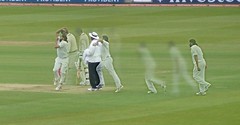Dancing with brains: How to to use your feet to spin without getting stumped (part 2)

 photo credit: al_green
photo credit: al_greenThis is part two of a two part series on using your feet to spin bowling. To go back to part one, click here.
Using your feet to spin is a very effective way to maintain control over a bowler.
But it's a game of risk reduction: pick the right ball at the right time. That's why the great players of spin are able to use their feet without getting stumped. What else can we learn from the way these players approach the technique?
Here is what I have observed the good players of spin doing when they have decided to move down the wicket.
Be a surgeon
If you have an operation you are going to want the surgeon works with control, accuracy and precision. You certainly want to avoid the guy who wants to hack away with gay abandon. Your batting against spin should be like the former. Not that any surgeons do the latter, but a lot of batsmen do when coming down the wicket.
I think this stems from a misguided assumption: If you come down the wicket you have to smash it. Not only is this wrong, it's the highest risk way to play spin. What happens to most batsmen if they try and hit it too hard? They lose their technique, they take their eye off the ball and either miss it or loop it straight to a fielder.
The alternative is to place the ball into the gaps. Much of the success of good batsmen can be found in their mindset: Stay in control. Look for areas to hit the ball. Place it where the fielders aren't. You can still hit boundaries this way and even clear the rope. However, you are doing it on your terms and not the bowlers. Make your watch words 'pinpoint placement'.
Play straight
Coaches the world over insist their charges play with a straight bat. As Bob Woolmer always pointed out, a cricket bat is a lot longer than it is wide. This is good advice when coming down the track because it increases your chances of hitting the ball. And we are all about increasing chances right? Plus, you will mostly be hitting balls of low full toss or half volley length to drive.
If the bowler has spotted you coming and drops his length back the obvious choice is a forward defensive. This means cutting out risky shots like cuts and square drives where your bat is away from your body and you are likely to miss it. The pull shot might be OK in some circumstances but the ball would have to be a terrible long hop for it still to be short when you are a yard or two down.
However you look at it, playing straight with good technique gives maximum return for the average club batsman.
You don't have to score runs
As I alluded to previously, sometimes it's prudent to block when coming down the track. This is the last resort as it gives the bowler a little win, but it's far superior to walking back to the pavilion after looking like a mug. When should you block?
- When you have misjudged the flight of the ball
- When the bowler has spotted you moving and has dropped his length back
- When you are not totally confident that you can make contact with an attacking stroke
You can use your bat or your pad, just get something in the way. It would take a brave umpire to give an LBW when you are so far down. The take away message is this: While coming down the track is an aggressive move you are not obliged to hit it. Always have a backup plan to play a defensive shot if all else fails.
Practice, practice, practice
I saved the most important part to last. Although I know what you are thinking: Everybody knows you need to practice to get better. Duh! All I ask you to think about when it comes to practice is this: Are you getting the most from it? To improve a skill you need to learn the correct technique, groove it through repetition then apply it under pressure. Have you gone through this process when coming down the wicket or are you winging it?
Remember, using your feet to spin is about reducing risk while scoring runs, not hitting and hoping. Having a technique you can trust is the most important part of playing spin. You can only get that through deliberate practice or blind luck. I know which one I would prefer.
What does this all boil down to?
If you follow the tips from these two days you are not only improving your chances, you are improving your confidence. So much batting is done in your head. If you can play without fear then coming down the wicket becomes an easy to implement tactic.
If you want to learn everything there is to know about playing spin, check out Gary Palmer's interactive coaching course - The Complete Guide to Effectively Playing Spin Bowling. Gary is a coach with over 20 years experience teaching players to become first class cricketers. For the first time he has put his drills online, only at PitchVision Academy.
- Login to post comments



Comments
[...] This is part one of a two part series on using your feet to spin bowling. To go to part two click here. [...]
Thanx' 4 2 this